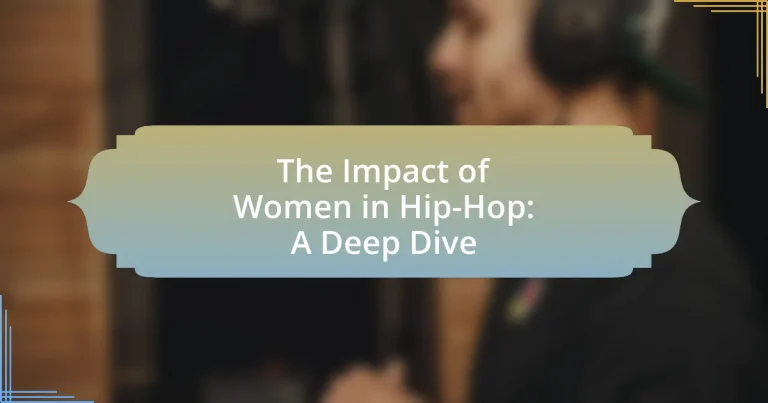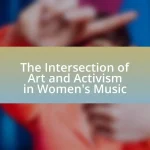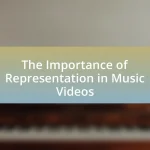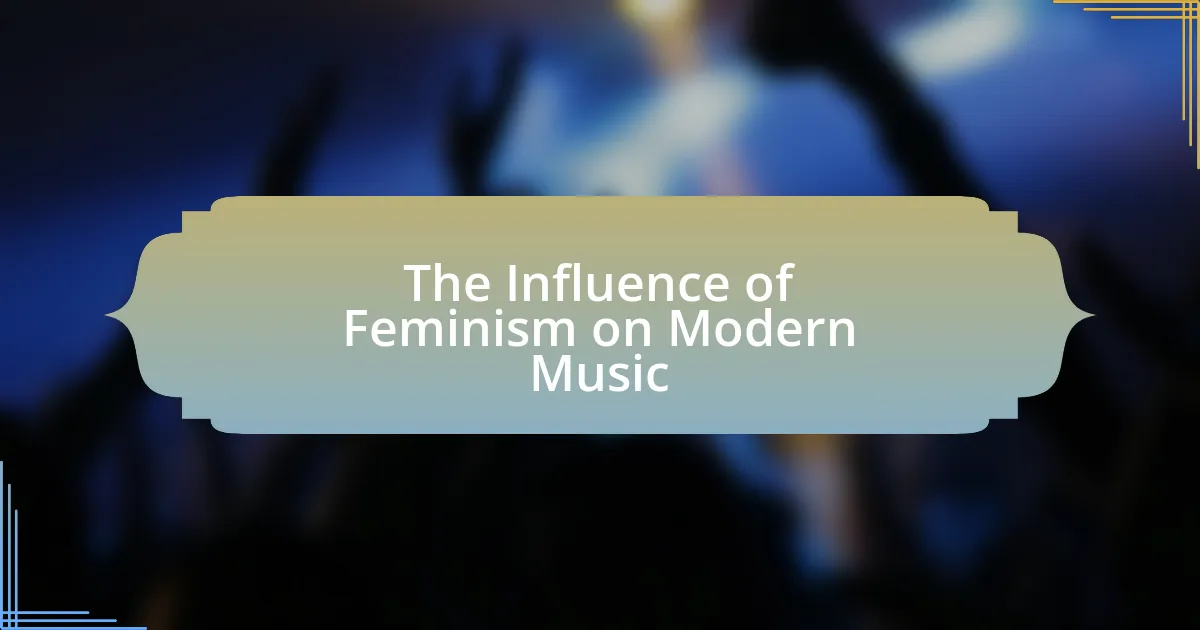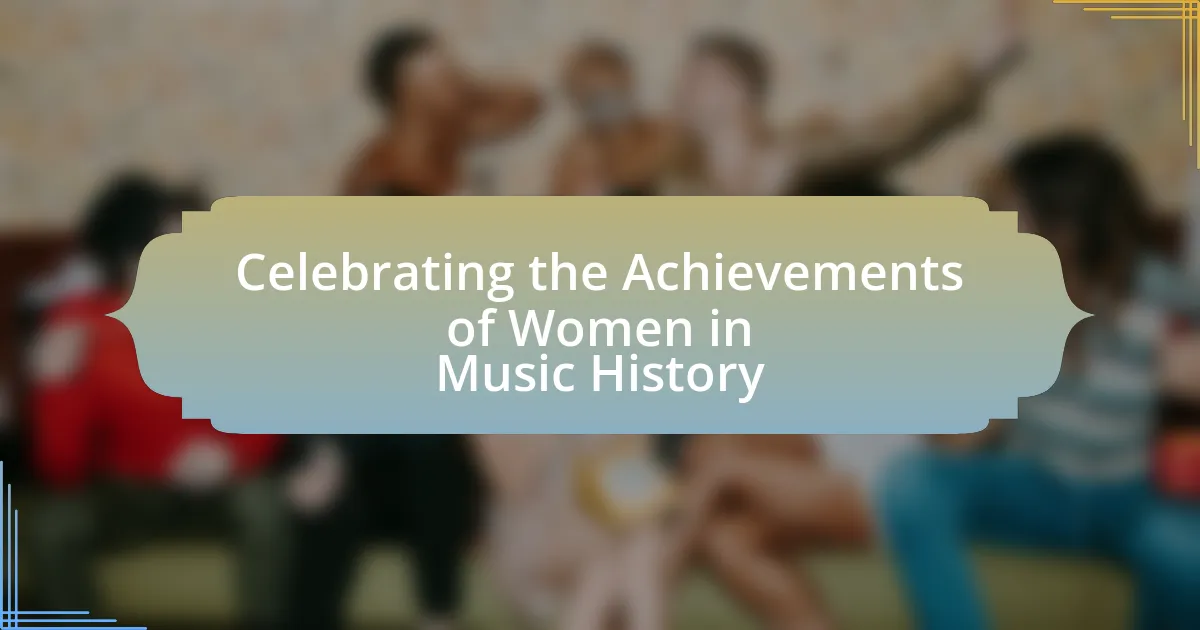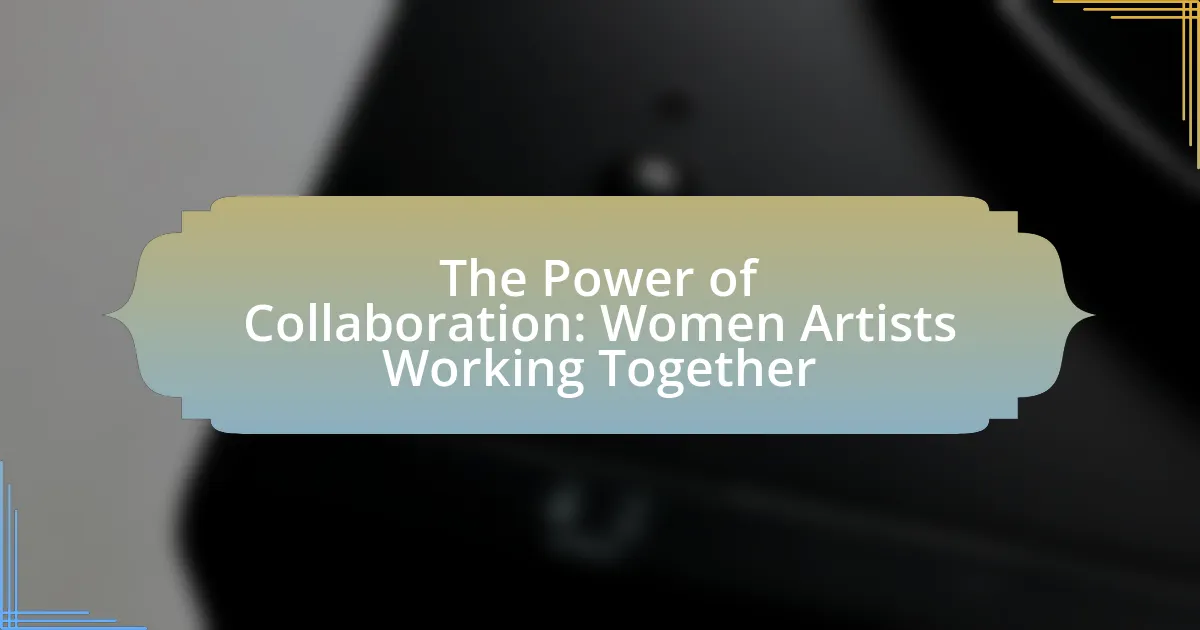The article examines the significant impact of women in hip-hop, highlighting their roles in shaping the genre and challenging gender norms. It discusses the contributions of pioneering artists such as Queen Latifah and Missy Elliott, as well as contemporary figures like Nicki Minaj and Cardi B, who continue to redefine female representation. The article also addresses the ongoing challenges women face in the industry, including gender discrimination and underrepresentation, while emphasizing the importance of female visibility and collaboration in promoting diversity within hip-hop culture. Additionally, it explores current trends, opportunities for aspiring female artists, and initiatives aimed at fostering gender equality in the genre.
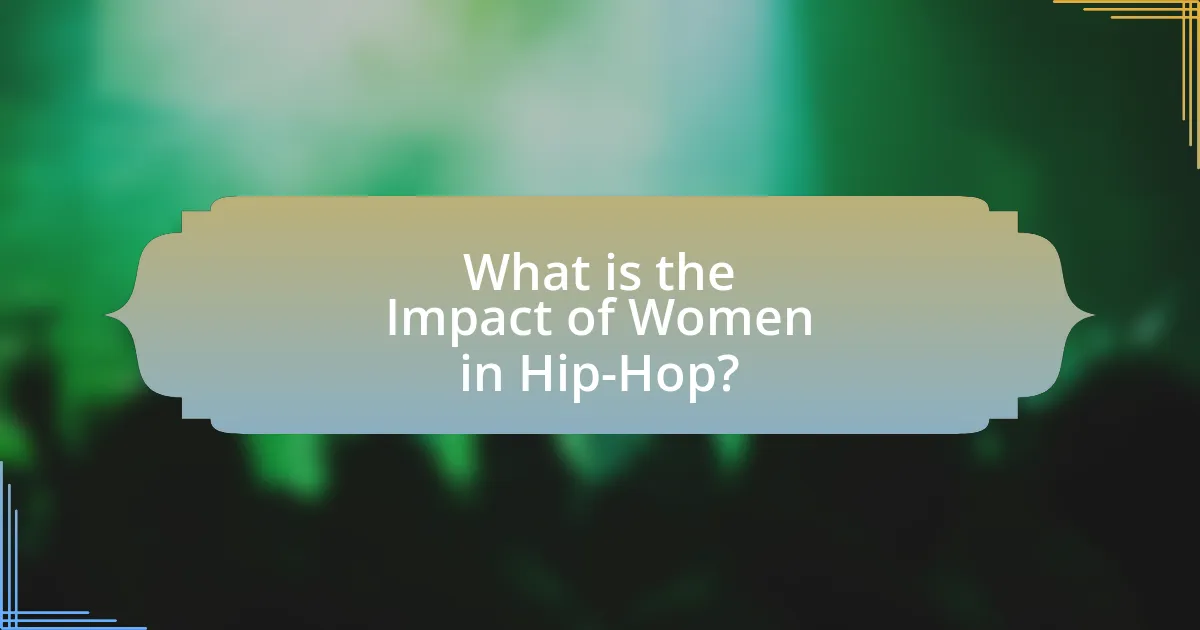
What is the Impact of Women in Hip-Hop?
Women in hip-hop have significantly shaped the genre by challenging gender norms, influencing lyrical content, and expanding the cultural landscape. Pioneers like Queen Latifah and Missy Elliott broke barriers, paving the way for contemporary artists such as Nicki Minaj and Cardi B, who continue to redefine female representation in the industry. According to a 2020 study by the Annenberg Inclusion Initiative, women comprised only 21.7% of artists in popular music, highlighting the ongoing struggle for equality. However, the impact of women in hip-hop extends beyond statistics; they have used their platforms to address social issues, advocate for women’s rights, and inspire future generations, thereby solidifying their role as vital contributors to the genre’s evolution.
How have women shaped the evolution of hip-hop culture?
Women have significantly shaped the evolution of hip-hop culture through their contributions as artists, producers, and influencers. Pioneers like MC Lyte and Queen Latifah broke barriers in the late 1980s and early 1990s, establishing female voices in a predominantly male industry. Their lyrics often addressed social issues, empowering women and challenging gender stereotypes.
In the 1990s, artists such as Missy Elliott and Lil’ Kim further transformed the genre by introducing innovative styles and bold imagery, expanding the narrative scope of hip-hop. Missy Elliott’s unique production techniques and creative music videos redefined the visual aspect of hip-hop, while Lil’ Kim’s unapologetic expression of sexuality challenged traditional norms.
Moreover, women like Nicki Minaj and Cardi B have continued this legacy, achieving commercial success and using their platforms to advocate for women’s rights and representation in the industry. Their influence is evident in the growing presence of female artists in hip-hop charts and award shows, reflecting a shift towards greater inclusivity.
Overall, women’s contributions have not only enriched hip-hop culture but have also played a crucial role in its evolution, making it more diverse and representative of various experiences.
What roles have women played in the early days of hip-hop?
Women played crucial roles in the early days of hip-hop, serving as artists, DJs, dancers, and promoters. Notable figures include MC Sha-Rock, who was one of the first female MCs and helped to establish the presence of women in rap music. Additionally, women like Debbie Harry of Blondie collaborated with hip-hop artists, bringing mainstream attention to the genre. The Rock Steady Crew, which included female dancers, showcased women’s contributions to breakdancing and street culture. These roles were significant in shaping the hip-hop landscape and challenging gender norms within the music industry.
How have female artists influenced hip-hop’s musical styles?
Female artists have significantly influenced hip-hop’s musical styles by introducing diverse lyrical themes, innovative flows, and unique production techniques. Pioneers like Queen Latifah and MC Lyte expanded the genre’s narrative scope by addressing social issues, empowerment, and identity, which reshaped the lyrical content of hip-hop. Additionally, artists such as Missy Elliott and Nicki Minaj have incorporated elements from various genres, including R&B and pop, into their music, thereby broadening hip-hop’s appeal and sound. Their contributions have led to the emergence of sub-genres and collaborations that reflect a fusion of styles, demonstrating the vital role women play in the evolution of hip-hop.
Why is the representation of women in hip-hop important?
The representation of women in hip-hop is important because it challenges gender stereotypes and promotes diversity within the genre. Women artists, such as Missy Elliott and Nicki Minaj, have not only achieved commercial success but have also used their platforms to address issues like sexism and empowerment. Research indicates that female representation in hip-hop can lead to a broader acceptance of women’s voices in music, as evidenced by the increasing number of female artists charting on Billboard. This visibility helps to reshape cultural narratives and encourages young women to pursue careers in music, thereby fostering a more inclusive industry.
What challenges do women face in the hip-hop industry?
Women in the hip-hop industry face significant challenges, including gender discrimination, sexual objectification, and limited access to opportunities. Gender discrimination manifests in the form of unequal treatment and representation, as women are often sidelined in a male-dominated industry. Sexual objectification is prevalent, with female artists frequently pressured to conform to hypersexualized images to gain visibility. Limited access to opportunities is evidenced by the underrepresentation of women in key roles such as producers, executives, and decision-makers, which restricts their influence and career advancement. According to a 2020 study by the Annenberg Inclusion Initiative, only 21.7% of artists in popular music were women, highlighting the systemic barriers they encounter.
How does female representation affect audience perception of hip-hop?
Female representation significantly enhances audience perception of hip-hop by promoting diversity and challenging stereotypes. When women are prominently featured in hip-hop, they contribute unique perspectives and narratives that broaden the genre’s appeal, attracting a wider audience. Research indicates that female artists like Nicki Minaj and Cardi B have not only achieved commercial success but have also reshaped the cultural landscape of hip-hop, encouraging discussions around gender equality and empowerment. This shift in representation leads to increased acceptance and appreciation of female voices, ultimately enriching the overall hip-hop experience for listeners.
What are the key contributions of women in hip-hop?
Women have made significant contributions to hip-hop by shaping its culture, expanding its themes, and influencing its sound. Pioneers like MC Lyte and Queen Latifah broke barriers in the late 1980s and early 1990s, establishing female voices in a predominantly male genre. Their work not only showcased lyrical prowess but also addressed social issues, empowering women and promoting gender equality within the music industry.
In the 1990s and 2000s, artists such as Missy Elliott and Lil’ Kim further revolutionized hip-hop by introducing innovative styles and visuals, blending genres, and challenging societal norms regarding femininity and sexuality. Their influence is evident in contemporary artists like Nicki Minaj and Cardi B, who continue to push boundaries and redefine the role of women in hip-hop.
Moreover, women in hip-hop have also contributed behind the scenes as producers, DJs, and executives, shaping the industry’s landscape. For instance, Sylvia Rhone became the first female president of a major record label, paving the way for future generations. Overall, the contributions of women in hip-hop have been crucial in diversifying the genre and promoting a more inclusive narrative.
Which female artists have made significant impacts in hip-hop history?
Notable female artists who have made significant impacts in hip-hop history include Queen Latifah, Missy Elliott, and Nicki Minaj. Queen Latifah, active since the late 1980s, is recognized for her pioneering role in bringing feminist themes to hip-hop and for her crossover success in music and acting. Missy Elliott revolutionized the genre in the late 1990s and early 2000s with her innovative music videos and unique sound, earning multiple Grammy Awards and critical acclaim. Nicki Minaj, emerging in the late 2000s, has broken numerous records, including being the first female artist to have 100 entries on the Billboard Hot 100, showcasing her influence and commercial success in the industry.
How have women in hip-hop addressed social issues through their music?
Women in hip-hop have addressed social issues through their music by using their platforms to highlight topics such as gender inequality, racial injustice, and empowerment. For instance, artists like Queen Latifah in her song “U.N.I.T.Y.” advocate for respect and equality for women, directly confronting misogyny in the industry. Similarly, Nicki Minaj has tackled issues of body image and self-acceptance in tracks like “Anaconda,” promoting body positivity. Additionally, artists such as Rapsody and Lauryn Hill have addressed systemic racism and the struggles of Black communities, with Rapsody’s “Power” emphasizing the importance of representation and resilience. These examples illustrate how women in hip-hop not only express their personal experiences but also engage with broader societal challenges, making their music a powerful tool for social commentary and change.
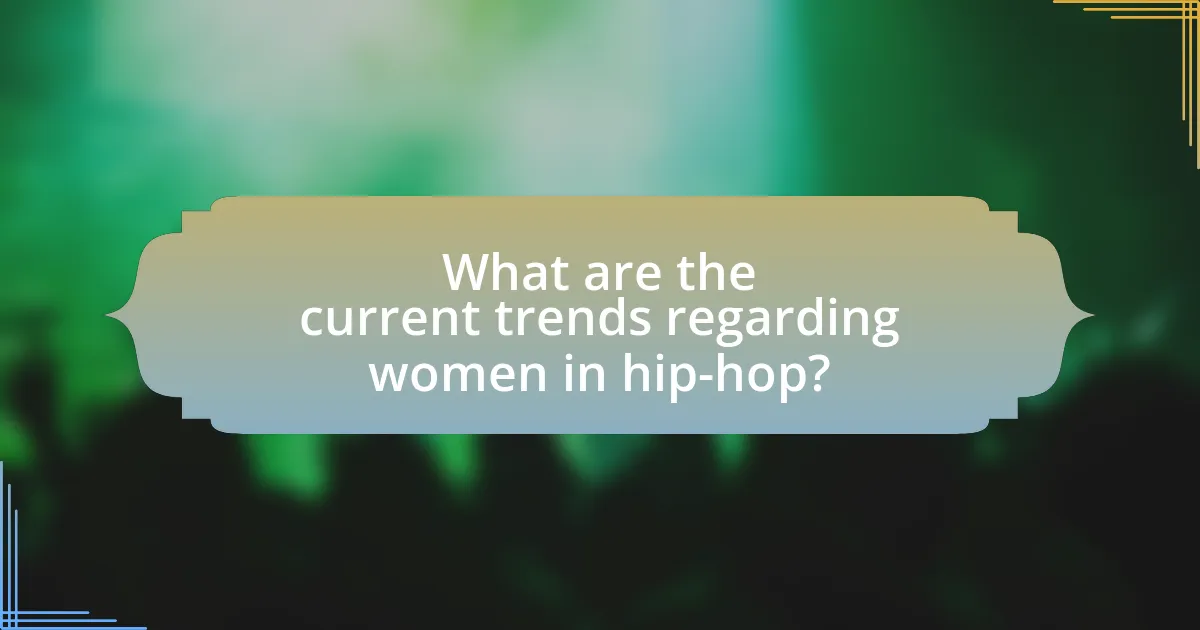
What are the current trends regarding women in hip-hop?
Current trends regarding women in hip-hop include a significant rise in visibility and influence, with female artists increasingly dominating charts and award shows. For instance, in 2023, women like Nicki Minaj, Cardi B, and Megan Thee Stallion have consistently topped Billboard charts, showcasing their commercial success. Additionally, there is a growing emphasis on empowerment and authenticity in their lyrics, reflecting personal experiences and social issues. This shift is supported by data from the Recording Industry Association of America, which reported that female artists accounted for 30% of the top 100 songs in 2022, a notable increase from previous years. Furthermore, collaborations among female artists are becoming more common, fostering a sense of community and support within the genre.
How are contemporary female artists redefining hip-hop?
Contemporary female artists are redefining hip-hop by challenging traditional gender roles and introducing diverse narratives. Artists like Nicki Minaj, Cardi B, and Megan Thee Stallion have gained prominence by asserting their sexuality, independence, and empowerment through their lyrics and public personas. For instance, Cardi B’s hit “Bodak Yellow” not only topped charts but also showcased a narrative of self-made success, resonating with many women. Additionally, the rise of platforms like social media has allowed these artists to connect directly with their audiences, amplifying their voices and perspectives in a genre historically dominated by men. This shift is evident in the increasing representation of women in hip-hop charts and award nominations, reflecting a broader acceptance and celebration of female talent in the industry.
What new genres or styles are emerging from women in hip-hop today?
Women in hip-hop today are emerging with genres and styles such as trap, alternative hip-hop, and genre-blending sounds that incorporate elements of R&B, pop, and electronic music. Artists like Megan Thee Stallion and Doja Cat exemplify this trend by fusing traditional rap with melodic hooks and diverse production styles, appealing to a broader audience. Additionally, the rise of feminist themes and personal storytelling in tracks by artists like Tierra Whack and Rapsody showcases a shift towards more introspective and socially conscious content, reflecting the evolving landscape of hip-hop.
How are social media and technology influencing female hip-hop artists?
Social media and technology are significantly empowering female hip-hop artists by providing platforms for self-promotion, audience engagement, and creative expression. These tools enable artists to bypass traditional gatekeepers in the music industry, allowing them to share their music directly with fans and build their own brands. For instance, platforms like Instagram and TikTok have become essential for artists to showcase their talent, with viral challenges and trends often leading to increased visibility and opportunities. According to a report by the Pew Research Center, 72% of teens use Instagram, highlighting its role in shaping the careers of emerging female artists. Additionally, technology facilitates collaboration across geographical boundaries, enabling female artists to connect with peers and producers worldwide, further enhancing their reach and influence in the hip-hop genre.
What collaborations are shaping the future of women in hip-hop?
Collaborations between established and emerging female artists are significantly shaping the future of women in hip-hop. Notable partnerships, such as those between Megan Thee Stallion and Cardi B, have not only garnered commercial success but also highlighted the power of female unity in a traditionally male-dominated genre. Additionally, the collaboration between Doja Cat and SZA on “Kiss Me More” showcases how cross-genre partnerships can elevate women’s visibility and influence in hip-hop. These collaborations are crucial as they foster a supportive environment, encourage creativity, and challenge industry norms, ultimately paving the way for future generations of female artists.
Which partnerships between male and female artists are noteworthy?
Noteworthy partnerships between male and female artists in hip-hop include the collaborations of Jay-Z and Alicia Keys on “Empire State of Mind,” which became an anthem for New York City and showcased the blending of rap and R&B. Another significant partnership is that of Kendrick Lamar and SZA on “All the Stars,” featured in the “Black Panther” soundtrack, which received critical acclaim and highlighted the synergy between their distinct styles. Additionally, the collaboration between Nicki Minaj and Drake on tracks like “Moment 4 Life” has been influential in shaping the genre, demonstrating the power of male-female dynamics in hip-hop. These partnerships not only achieved commercial success but also contributed to the evolution of hip-hop by integrating diverse musical elements and perspectives.
How do collaborations enhance the visibility of women in hip-hop?
Collaborations enhance the visibility of women in hip-hop by creating opportunities for female artists to reach broader audiences through joint projects. When women collaborate with established male artists or other female artists, they gain access to the latter’s fan bases, which can significantly increase their exposure. For instance, the collaboration between Nicki Minaj and Ariana Grande on the song “Bang Bang” not only showcased their talents but also introduced both artists to each other’s audiences, resulting in increased streaming numbers and chart success. Additionally, collaborations often lead to media coverage and promotional opportunities that further elevate the profiles of the women involved, contributing to a more balanced representation in a male-dominated industry.
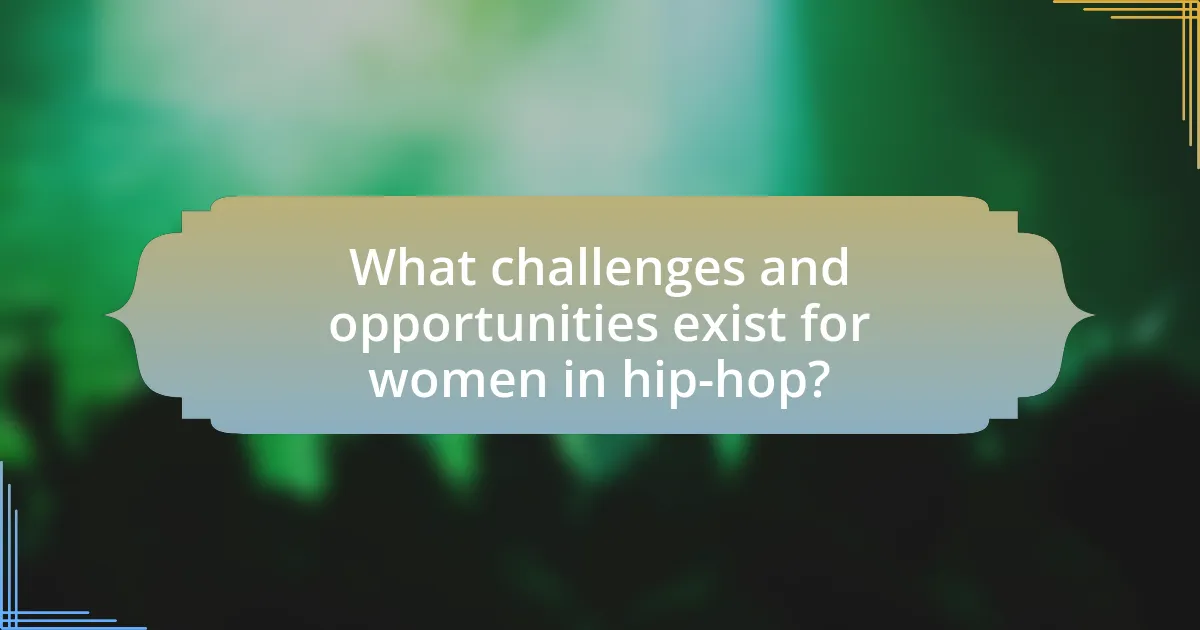
What challenges and opportunities exist for women in hip-hop?
Women in hip-hop face significant challenges, including gender discrimination, underrepresentation, and societal stereotypes. Despite these obstacles, there are also opportunities for women to gain visibility, influence, and success in the industry. For instance, the rise of female artists like Nicki Minaj and Cardi B has demonstrated that women can achieve commercial success and critical acclaim, paving the way for future generations. According to a 2021 report by the Annenberg Inclusion Initiative, women comprised only 21.7% of artists in the hip-hop genre, highlighting the ongoing challenge of representation. However, initiatives aimed at promoting female talent and the growing support for women-led projects indicate a positive shift, creating a more inclusive environment in hip-hop.
What barriers do women face in achieving success in hip-hop?
Women face significant barriers in achieving success in hip-hop, primarily due to systemic sexism, lack of representation, and industry gatekeeping. Systemic sexism manifests in the form of gender bias, where female artists often encounter skepticism regarding their talent and credibility compared to their male counterparts. According to a study by the Annenberg Inclusion Initiative, only 22.5% of artists in popular music are women, highlighting the lack of representation in the industry. Additionally, women in hip-hop frequently face challenges related to sexual objectification and the pressure to conform to stereotypical roles, which can hinder their artistic expression and career advancement. Furthermore, industry gatekeeping by predominantly male executives and decision-makers limits opportunities for women to secure contracts, airplay, and promotional support, reinforcing the barriers they face in achieving success.
How does sexism manifest in the hip-hop industry?
Sexism in the hip-hop industry manifests through objectification of women, gender-based violence, and unequal representation. Female artists often face derogatory lyrics that reduce them to sexual objects, as seen in numerous tracks by male rappers, which perpetuates harmful stereotypes. Additionally, women in hip-hop frequently encounter barriers to entry and advancement, with only 22% of artists in the genre being female, according to a 2020 study by the Annenberg Inclusion Initiative. This disparity highlights the systemic challenges women face, including limited opportunities for recognition and support compared to their male counterparts.
What steps are being taken to combat gender inequality in hip-hop?
Efforts to combat gender inequality in hip-hop include initiatives aimed at increasing female representation, promoting female artists, and addressing misogyny within the genre. Organizations like Women in Hip Hop and the Hip Hop Association work to create platforms for women, providing resources and networking opportunities. Additionally, campaigns such as #MeToo and #TimesUp have raised awareness about sexual harassment and discrimination in the industry, leading to more discussions about gender equity. Research indicates that female artists are increasingly gaining visibility, with a notable rise in chart-topping female rappers, which reflects a shift towards inclusivity in hip-hop culture.
What opportunities are available for aspiring female hip-hop artists?
Aspiring female hip-hop artists have numerous opportunities to advance their careers, including participation in music festivals, collaborations with established artists, and access to mentorship programs. Music festivals like the Women in Music Festival and the Femme Fest specifically highlight female talent, providing platforms for exposure and networking. Collaborations with established artists can lead to increased visibility and credibility within the industry, as seen with artists like Nicki Minaj and Cardi B, who have successfully collaborated with various musicians. Additionally, mentorship programs such as She Is the Music offer guidance and resources tailored to women in the music industry, helping them navigate challenges and build their careers effectively.
How can mentorship programs support women in hip-hop?
Mentorship programs can support women in hip-hop by providing guidance, networking opportunities, and skill development tailored to their unique challenges in the industry. These programs often connect emerging female artists with established professionals, fostering an environment where knowledge and experience can be shared. For instance, initiatives like the “Women in Hip-Hop” mentorship program have successfully paired young female artists with mentors who offer insights into navigating the male-dominated landscape, thus enhancing their confidence and career prospects. Research indicates that mentorship can significantly increase the likelihood of success for women in traditionally male-dominated fields, as it helps to build essential skills and expand professional networks.
What resources are available for women looking to enter the hip-hop scene?
Women looking to enter the hip-hop scene can access various resources, including mentorship programs, workshops, and online platforms dedicated to female artists. Organizations like the Women’s Audio Mission provide training in music production and audio engineering specifically for women, while platforms such as She Is the Music focus on empowering female musicians through networking and educational opportunities. Additionally, social media groups and forums offer community support and collaboration opportunities, enabling women to connect with industry professionals and peers. These resources collectively foster an inclusive environment for women in hip-hop, promoting their visibility and success in the industry.
What can be done to further support women in hip-hop?
To further support women in hip-hop, industry stakeholders must prioritize equitable opportunities for female artists. This includes increasing funding for female-led projects, ensuring representation in decision-making roles, and providing mentorship programs that connect emerging female talent with established artists. Research indicates that female artists receive significantly less airplay and promotional support compared to their male counterparts, highlighting the need for systemic changes to create a more inclusive environment. By implementing these strategies, the hip-hop industry can foster a more diverse and supportive landscape for women.
How can fans contribute to the success of female hip-hop artists?
Fans can contribute to the success of female hip-hop artists by actively supporting their music through streaming, purchasing albums, and attending live performances. This financial support directly impacts the artists’ revenue and visibility in the industry. For instance, according to a 2021 report by the Recording Industry Association of America, streaming accounted for 83% of the music industry’s revenue, highlighting the importance of fan engagement in driving sales and chart performance. Additionally, fans can amplify female artists’ reach by sharing their work on social media platforms, which can lead to increased exposure and new audience growth. Engaging in conversations about their music and advocating for their recognition in award shows further solidifies their place in the industry.
What initiatives are effective in promoting gender equality in hip-hop?
Effective initiatives promoting gender equality in hip-hop include mentorship programs, female-focused music festivals, and educational workshops. Mentorship programs, such as those offered by organizations like Women in Hip Hop, connect aspiring female artists with established professionals, fostering skill development and industry knowledge. Female-focused music festivals, like the Femme Fest, provide platforms for women artists to showcase their work, increasing visibility and representation. Educational workshops, often hosted by industry veterans, teach young women about the music business, empowering them to navigate the industry effectively. These initiatives collectively contribute to a more equitable environment in hip-hop, as evidenced by the increasing number of women artists gaining recognition and success in the genre.
